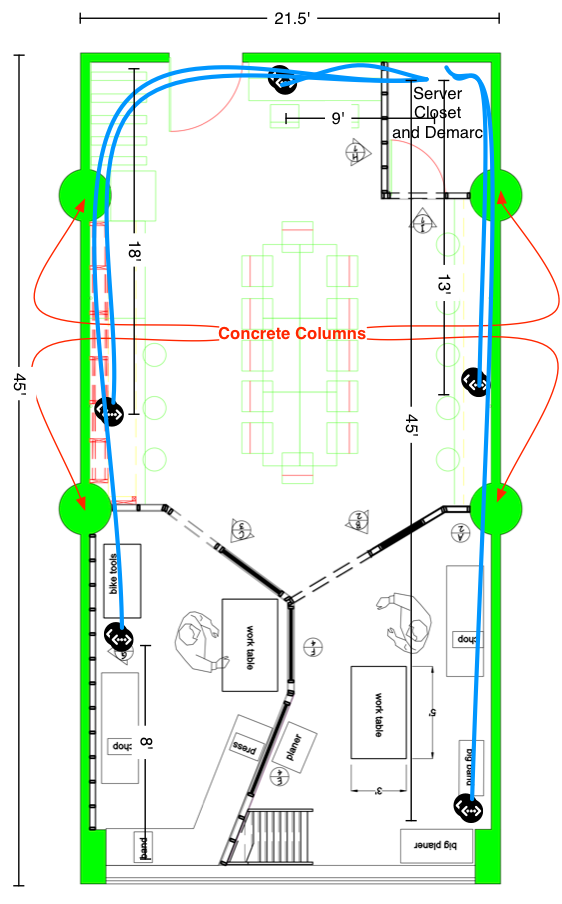Network Drops and Cabling
Jump to navigation
Jump to search
Contents
Physical network considerations
- How many drops do we need? Where?
- Do we expect high amounts of EMF?
- Do we care about restricting access to the wireless network?
- Should we consider drops to points of entry (for security checkpoints, display dashboards, or more?)
- What policies should we have in place if someone wants to expand the location of network drops?
Proposed layout
I'd like to get at least two physical drops in every interesting place. Our network backbone and internet link are both pretty narrow (by 2014 standards), which means that it's unlikely we'll see a bottleneck be a small switch attached to a drop point if we need more than the two available.
Limitations of network drops
We have some challenges to overcome when doing these drops.
- Concrete Columns - These columns are wide, and concrete. We can't drill through them to put cables in them, nor easily attach things to them. They're also floor-to-ceiling, so there's no good way around them
- Ceiling - The ceiling, is concrete and 16' up. It's not likely a good place to attach cables.
- Cable visibility - There's no way around this - we're going to see cabling.
Needed equipment
Some way to attach the cable to the wall. Options are:
- http://www.discount-low-voltage.com/Cable-Management/J-Hooks/ERICO-CAT12 Erico J-hooks
- http://www.amazon.com/Arlington-TL20-100-Hangers-Communications-100-Pack/dp/B00422M2CG Arlington The Loop hooks (though I'm not sure how these work - I'd like to get an eval item)
- http://www.amazon.com/Platinum-Tools-JH802-100-Bridle-Ring/dp/B00HWYB5WE/ref=sr_1_5?ie=UTF8&qid=1394383188&sr=8-5&keywords=bridle+ring Bridle rings are also an option, but we'd have to get ones specifically for high-speed cable, fashion some force-spreader of some sort, or run them very close to each other - they're notorious for causing kinking in CAT5/6 cabling and failure. They've been historically used in these sort of applications, though.
Also:
- Wall jacks/surface-mount junction box ( http://www.amazon.com/gp/product/B0072JVTMA?gclid=CMKG9Kuvhr0CFecWMgodoXAA_w, http://www.amazon.com/gp/product/B0072JVTMA?gclid=CMKG9Kuvhr0CFecWMgodoXAA_w )
- Keystone jacks (http://www.amazon.com/gp/product/B0072JVTMA?gclid=CMKG9Kuvhr0CFecWMgodoXAA_w)
- Probably another pullbox (still need to do measurements)
- Punchdown tool (http://www.amazon.com/DataShark-70034-Non-Impact-Punchdown-Tool/dp/B000KMFDZ0/ref=sr_1_1?ie=UTF8&qid=1394399742&sr=8-1&keywords=cat6+punchdown+tool , I think we have one)
- CAT6 rated Patch panel ( http://www.amazon.com/Monoprice-107253-24-Port-Patch-Compatible/dp/B0069MHLCS/ref=sr_1_5?ie=UTF8&qid=1394399761&sr=8-5&keywords=24+port+patch+panel )
